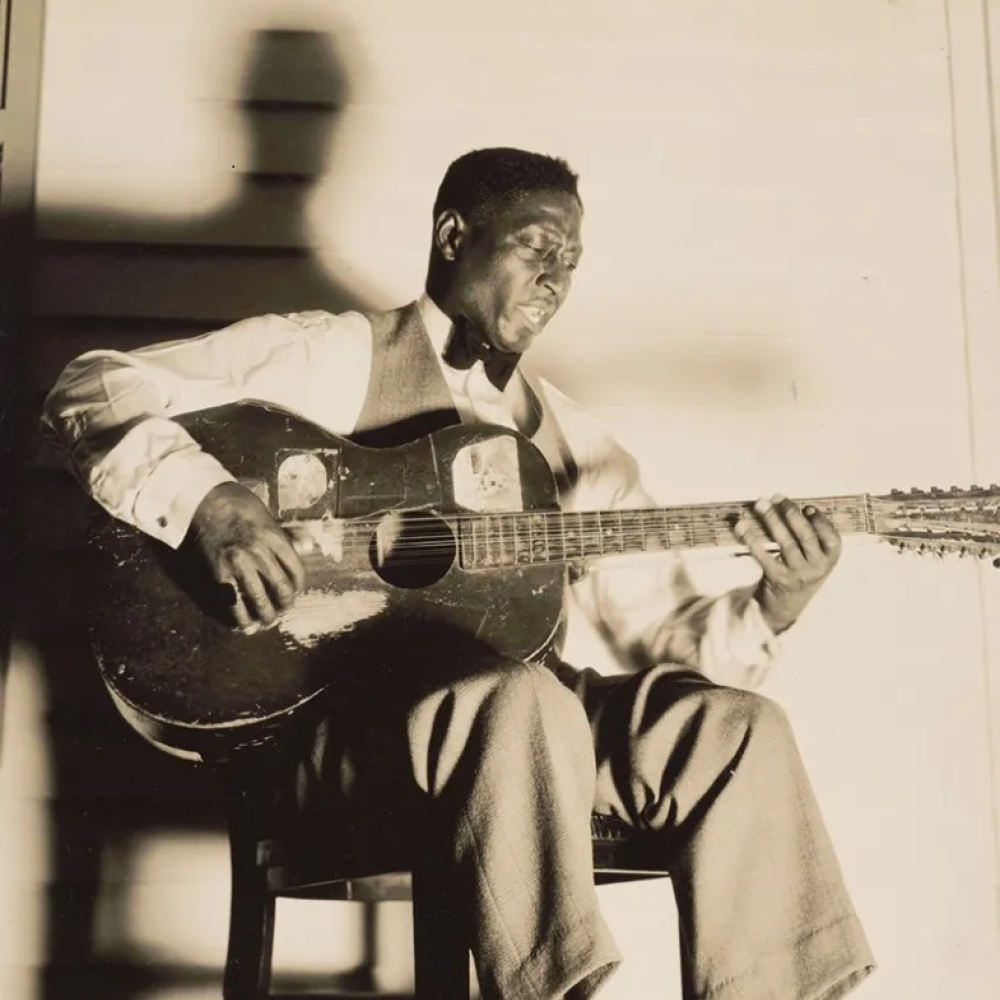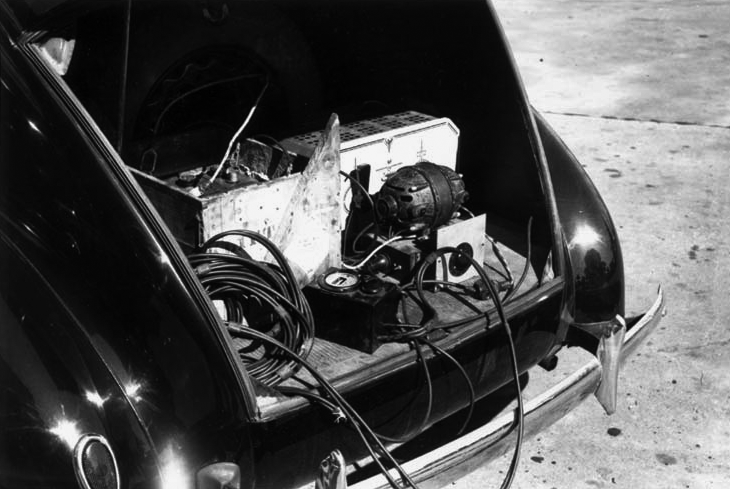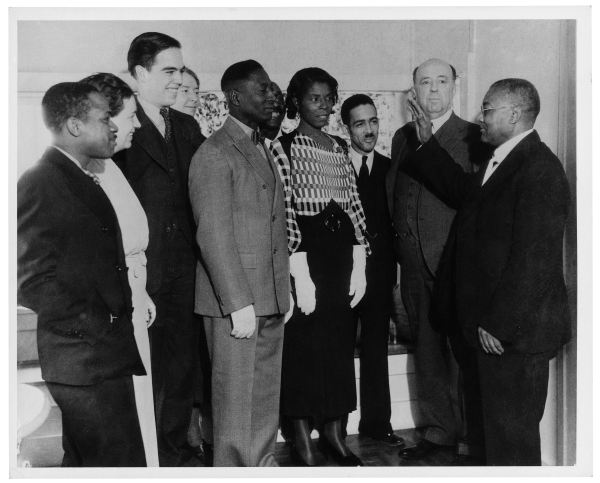In 1933, while touring southern states to record folk music on behalf of the Library of Congress, white folklorist John Lomax and his teenaged son, Alan, stopped at the Louisiana State Penitentiary at Angola. There, they met Black prisoner Huddie Ledbetter, better known today as the legendary musician Lead Belly, who would influence generations of folk and rock performers with such timeless hits as “Goodnight, Irene,” “The Rock Island Line,” and “In the Pines.” In July 1934, the Lomaxes returned to Angola to record again with Ledbetter. On August 1, through a “good time” allowance, he was released. By then, Alan was ill and had returned home to recover. Lomax, nearly sixty-seven years old, turned to Ledbetter, then forty-five, for help. “Come prepared to travel,” Lomax wired. “Bring guitar.”
Waiting alone at the hotel in Marshall, Texas, on that hot, overcast Monday in September 1934, John Lomax was facing several more weeks of collecting, and was almost certainly pleased when Huddie Ledbetter arrived. But rather than admit this or acknowledge the valuable assistance Ledbetter might provide, or even be forthcoming that they had been corresponding for weeks, John Lomax chose to present the encounter in Marshall, Texas, as being a complete surprise to him. In his 1936 book Negro Folk Songs as Sung by Lead Belly, Lomax says that he looked up from reading a newspaper in the Marshall hotel lobby “to see a Negro man standing timidly by my chair. He had touched my shoulder to draw my attention as he stood there, his face ashen with uncertainty and fear.” Lomax claims that he said, “Why, hello, Lead Belly! What are you doing here?” This is false; not only was Lomax anticipating Ledbetter’s arrival, but he had already planned an ambitious itinerary that would take them to prisons he had not yet visited in Arkansas, Alabama, Georgia, South Carolina, North Carolina, and Texas. Yet even two days later, writing to his wife, Lomax portrayed the meeting as a job interview. In his “first talk” with the performer, he wrote, he asked “what weapons he was carrying along.”
This scene would later be repeated in the Lomaxes’ book and—reaching much larger audiences—The March of Time, a national news magazine program that in 1935 carried stories about Ledbetter on the radio and in movie theaters. Lomax told Ruby that Ledbetter showed him a “dangerous looking” knife “with a long keen blade.” The knife, visible in the newsreel, is a pocketknife, and Lomax opens it to reveal a blade that appears to be about three inches long and less than an inch wide at the base. As Lomax would soon learn, Ledbetter sometimes used the knife in place of a guitar slide, in a style of performance described as “Hawaiian” or “bottleneck.” Ledbetter’s younger cousin, Queenie Pugh Davidson, described how Ledbetter had used the knife to suggest various sound effects: “He said he could make that guitar sound just like that train, that whistle.” Despite the fact that Lomax, like many men of his era, probably also carried some kind of utility knife—an especially useful tool for someone like Lomax, who camped by the roadside and often needed to repair jury-rigged recording equipment—he chose to present the knife in Ledbetter’s possession as a threat. With bravado that he later included in the book, he told his new wife that he’d warned Ledbetter, “Whenever you decide that you are going to take my money and car, you won’t have to use this knife on me. Just tell me what you want and I’ll give it to you without a struggle.” He claimed that Ledbetter was almost in tears as he answered, “Please, suh, don’t talk that way. You got me out of the pen. I’se your man. You won’t ever have to tie yo shoes again if you don’t want to. I’ll step in front of you if ever anybody tries to shoot you. I’m ready to die for you, Boss.” (When quoting Ledbetter in writing, Lomax used stereotypical dialect.)
This account gains some credibility by virtue of it being written so soon after the event, but the full nature of the conversation is elusive. Ledbetter had traveled to Marshall about a job he had watched young Alan Lomax perform. The recording machinery was not complicated, but it was unwieldy, heavy, and prone to breaking down, all of which Ledbetter could handle. Beyond that, Ledbetter understood more about the music being sought, and the men and women who performed it, than Lomax ever could. Lastly, he had been holding out for the promise of this job since his release, which meant that he had not earned any significant money for two months, on top of not having an income during the five years of his incarceration. Now, it seemed, the job he’d traveled to undertake was less than certain. The tone in Ledbetter’s letters prior to the meeting in Marshall—self-confident and eager for the work—seems to have shifted once the two men were together. Ledbetter may have assessed, quickly, that this white patrician southerner had specific expectations of who he was and how he should behave. His pledge of loyalty clearly flattered Lomax, because Lomax repeated it often in the weeks and months to come.
It’s not clear how or when Lomax made it clear that the “job” he had for Ledbetter was unpaid, offering just an allowance, handed out daily, to cover food and housing as needed. Instead, as he later described the meeting, Lomax presented himself as a benefactor offering hope of redemption to a man who had none. Long after he knew that Ledbetter had a very close extended family and community along the Texas-Louisiana border, Lomax wrote: “I realized that probably no one in the world, except his woman, felt the slightest interest in him, that he might soon be back in the penitentiary for some crime against his own people.” The reasons that Ledbetter agreed to the financial terms are also not known, but there are a few possibilities. One is that he was not welcome in the Shreveport–Mooringsport–Oil City area, where he’d worked in the years before his 1930 arrest. Shreveport sheriff Tom Hughes had been notified of his release and was concerned, and possibly Ledbetter had been made aware of this. Additionally, after years of incarceration, the idea of traveling to areas he’d never been, meeting and sharing music with performers along the way, might have intrigued him. Finally, it seems likely that Lomax dangled a tantalizing promise: that if things worked out, he might bring the performer north and introduce him to influential people. This is supported by Lomax’s letters in the weeks that followed, and by a statement he made in the book: “Thirty minutes” after the meeting, “with Lead Belly at the wheel, we were on our way headed for the Negro prison camps of the State of Arkansas. Lead Belly’s Odyssey had begun. ‘I wants to see New Yawk.’”
Excerpted from Bring Judgment Day: Reclaiming Lead Belly’s Truths from Jim Crow’s Lies, published by Cambridge University Press. Reprinted with permission, all rights reserved.








